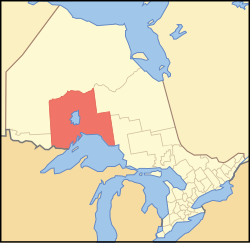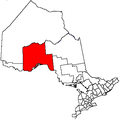Thunder Bay District
Thunder Bay District | |
|---|---|
District | |
 Location of Thunder Bay District in Ontario | |
| Coordinates: 50°N 88°W / 50°N 88°W / 50; -88Coordinates: 50°N 88°W / 50°N 88°W / 50; -88 | |
| Country | |
| Province | |
| Region | Northwestern Ontario |
| Created | 1871 |
| Government | |
| • MPs | Carol Hughes (NDP) Patty Hajdu (Liberal) Don Rusnak (Liberal) |
| • MPPs | Michael Gravelle (OLP) Michael Mantha (NDP) Judith Monteith-Farrell (NDP) |
| Area [1] | |
| • Land | 103,719.51 km2 (40,046.33 sq mi) |
| Elevation [2] | 220 m (720 ft) |
| Highest elevation | 640 m (2,100 ft) |
| Lowest elevation | 183 m (600 ft) |
| Population (2016)[3] | |
| • Total | 146,048 |
| • Density | 1.4/km2 (4/sq mi) |
| Time zone | UTC-6 (CST) |
| • Summer (DST) | UTC-5 (CDT) |
| Postal code span | P0S, P0T, P7A to P7G, P7J to P7L |
| Area code(s) | 807 |
| Largest communities [4] | Thunder Bay (109,140) Oliver Paipoonge (5,757) Greenstone (4,906) |

The eponymous Thunder Bay
Thunder Bay District is a district and census division in Northwestern Ontario in the Canadian province of Ontario. The district seat is Thunder Bay.
In 2016, the population was 146,048. The land area is 103,719.51 square kilometres (40,046.33 sq mi); the population density was 1.4 per square kilometre (3.6/sq mi).[1] Most of the district (93.5%) is unincorporated and part of the Unorganized Thunder Bay District.
Contents
1 History
2 Subdivisions
2.1 Municipalities
2.2 First Nations and their Indian Reserves
2.3 Unorganized areas
3 Demographics
4 Further reading
5 See also
6 References
History
Thunder Bay District was created in 1871 by provincial statute from the western half of Algoma District, named after a large bay on the north shore of Lake Superior. Its northern and western boundaries were uncertain until Ontario's right to Northwestern Ontario was determined by the Judicial Committee of the Privy Council.[5] Until about 1902 it was often called Algoma West from the name of the provincial constituency established in 1885.
The following districts include areas that were formerly part of Thunder Bay District:
Rainy River, created in 1885
Kenora, created in 1907 from Rainy River District
Cochrane, created in 1921
Subdivisions
Municipalities
- City of Thunder Bay
- Municipality (town) of Greenstone
- Town of Marathon
- Township of Conmee
- Township of Dorion
- Township of Gillies
- Township of Manitouwadge
- Municipality (township) of Neebing
- Township of Nipigon
- Township of O'Connor
- Municipality (township) of Oliver Paipoonge
- Township of Red Rock
- Township of Schreiber
- Township of Shuniah
- Township of Terrace Bay
First Nations and their Indian Reserves
Animbiigoo Zaagi'igan Anishinaabek First Nation: Lake Nipigon
Aroland First Nation: Aroland Settlement (Aroland 83)
Biinjitiwabik Zaaging Anishnabek First Nation (Rocky Bay): Rocky Bay 1
Bingwi Neyaashi Anishinaabek First Nation (Sand Point)
Fort William First Nation: Fort William 52
Ginoogaming First Nation: Ginoogaming (Long Lac 77)
Kiashke Zaaging Anishinaabek First Nation (Gull Bay): Gull River 55
Lac des Mille Lacs First Nation: Lac des Mille Lacs 22A1, Seine River 22A2
Long Lake 58 First Nation: Long Lake 58
Namaygoosisagagun First Nation (non-status)
Ojibway Nation of Saugeen First Nation (Savant Lake): Ojibway Nation of Saugeen
Ojibways of the Pic River First Nation: Pic River 50
Pays Plat First Nation: Pays Plat 51
Pic Mobert First Nation: Pic Mobert North, Pic Mobert South
Red Rock First Nation (Lake Helen): Lake Helen 53A, Red Rock 53
Seine River First Nation: Seine River 23A, Seine River 23B
Whitesand First Nation: Armstrong Settlement, Whitesand
Unorganized areas
Thunder Bay, Unorganized (including the local services boards of Armstrong, East Gorham, Hurkett, Kaministiquia, Lappe, Nolalu, Rossport, Savant Lake, Shebandowan, and Upsala)
Demographics
| Canada census – Thunder Bay District community profile | |||
|---|---|---|---|
2016 | 2011 | 2006 | |
| Population: | 146,048 (0.0% from 2011) | 146,057 (-2.0% from 2006) | 149,063 (-1.2% from 2001) |
| Land area: | 103,719.51 km2 (40,046.33 sq mi) | 103,706.27 km2 (40,041.21 sq mi) | |
| Population density: | 1.4/km2 (3.6/sq mi) | 1.4/km2 (3.6/sq mi) | |
| Median age: | 41.7 (M: 41.1, F: 42.3) | ||
| Total private dwellings: | 72,551 | 71,235 | 71,635 |
| Median household income: | |||
| Notes: *) Excludes census data for incompletely enumerated Indian reserves. – References: 2016[3] 2011[1] 2006[6] earlier[7] | |||
Almost 80 per cent of the district's population lives in the city of Thunder Bay Census Metropolitan Area; no other community in the district exceeds 7,000 in population.
Historic populations:[7]
- Population in 2001: 150,860
- Population in 1996: 157,619
Further reading
- Arthur, Elizabeth. Thunder Bay District, 1821-1892: A Collection of Documents. Toronto: Champlain Society Publications, 1973.
See also
| Wikimedia Commons has media related to Thunder Bay District, Ontario. |
- Edward Island (Lake Superior)
- Esnagami Lake
- List of Ontario Census Divisions
- List of townships in Ontario
References
^ abc "2011 Community Profiles". Canada 2011 Census. Statistics Canada. July 5, 2013. Retrieved 2012-03-20..mw-parser-output cite.citation{font-style:inherit}.mw-parser-output q{quotes:"""""""'""'"}.mw-parser-output code.cs1-code{color:inherit;background:inherit;border:inherit;padding:inherit}.mw-parser-output .cs1-lock-free a{background:url("//upload.wikimedia.org/wikipedia/commons/thumb/6/65/Lock-green.svg/9px-Lock-green.svg.png")no-repeat;background-position:right .1em center}.mw-parser-output .cs1-lock-limited a,.mw-parser-output .cs1-lock-registration a{background:url("//upload.wikimedia.org/wikipedia/commons/thumb/d/d6/Lock-gray-alt-2.svg/9px-Lock-gray-alt-2.svg.png")no-repeat;background-position:right .1em center}.mw-parser-output .cs1-lock-subscription a{background:url("//upload.wikimedia.org/wikipedia/commons/thumb/a/aa/Lock-red-alt-2.svg/9px-Lock-red-alt-2.svg.png")no-repeat;background-position:right .1em center}.mw-parser-output .cs1-subscription,.mw-parser-output .cs1-registration{color:#555}.mw-parser-output .cs1-subscription span,.mw-parser-output .cs1-registration span{border-bottom:1px dotted;cursor:help}.mw-parser-output .cs1-hidden-error{display:none;font-size:100%}.mw-parser-output .cs1-visible-error{font-size:100%}.mw-parser-output .cs1-subscription,.mw-parser-output .cs1-registration,.mw-parser-output .cs1-format{font-size:95%}.mw-parser-output .cs1-kern-left,.mw-parser-output .cs1-kern-wl-left{padding-left:0.2em}.mw-parser-output .cs1-kern-right,.mw-parser-output .cs1-kern-wl-right{padding-right:0.2em}
^ Highest point is 640m, located in Pukaskwa National Park. Thunder Bay is at 183m. 220 is an estimate
^ ab "2016 Community Profiles". Canada 2016 Census. Statistics Canada. February 21, 2017.
^ Compilation of Northwestern Ontario's 2006 census data
^ ONTARIO-MANITOBA BOUNDARY CASE "Archived copy". Archived from the original on 2012-10-04. Retrieved 2013-01-18.CS1 maint: Archived copy as title (link)
^ "2006 Community Profiles". Canada 2006 Census. Statistics Canada. March 30, 2011. Retrieved 2012-03-20.
^ ab "2001 Community Profiles". Canada 2001 Census. Statistics Canada. February 17, 2012.
